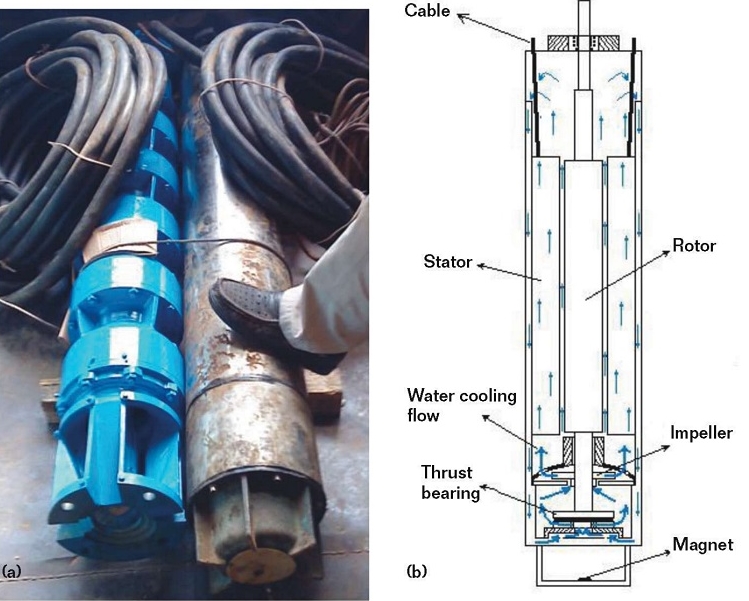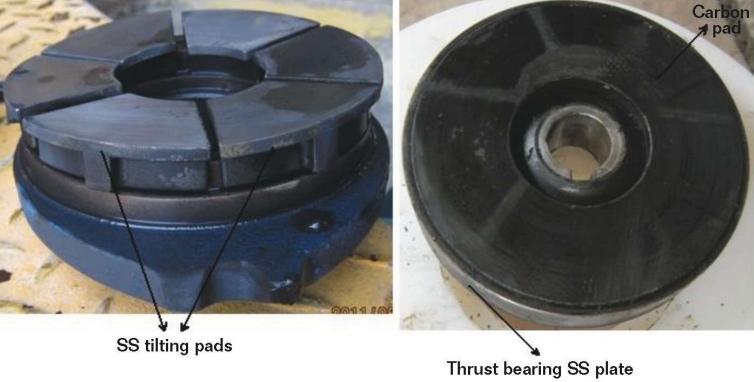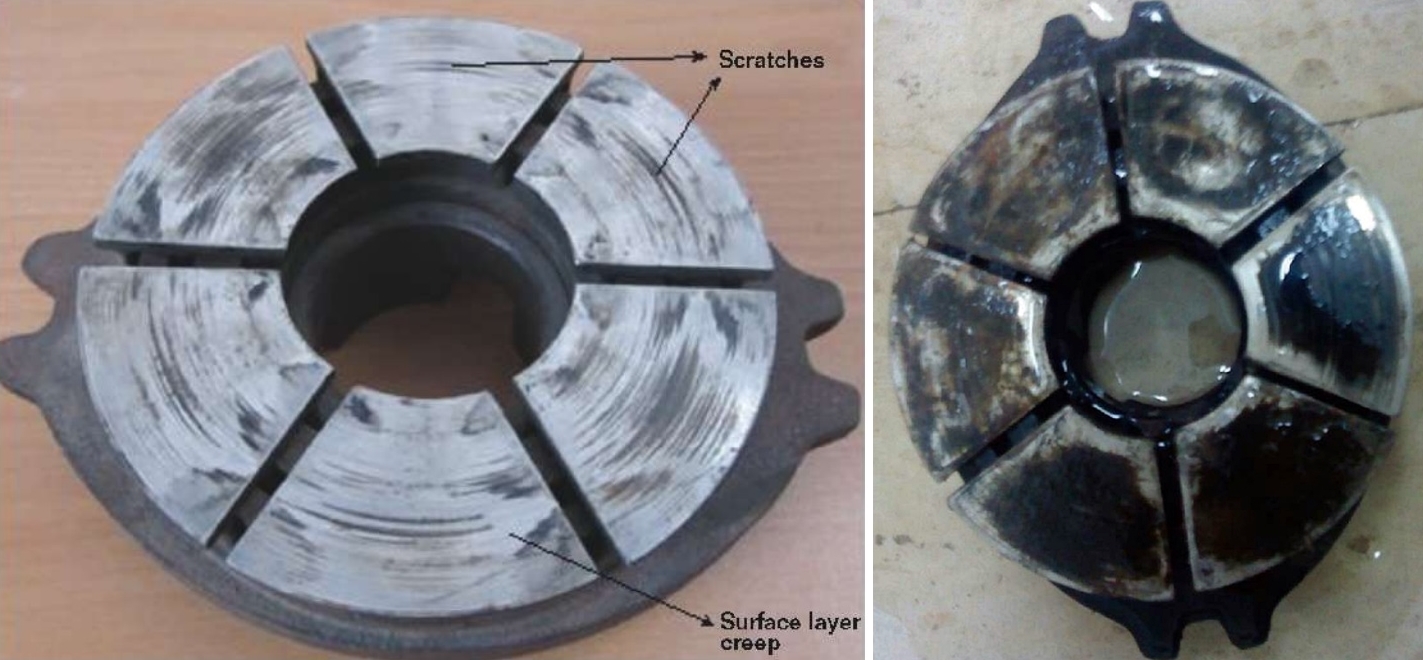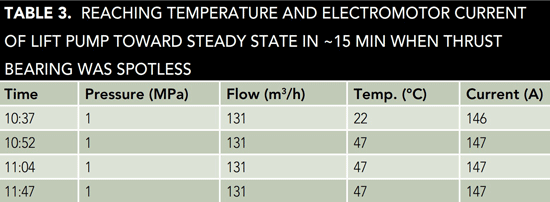On offshore platforms, vertical submersible pumps have an important role in petroleum extraction. They inject seawater into the wells to create sufficient pressure to extract oil. At the lower end of the lift pump’s electromotor, there is a water-lubricated thrust bearing that bears the weight of the rotor, pump shaft, and pressure of the water. Proper surface engineering is very important for the durability of the bearing and the electromotor. Surface creep and abrasive wear of the bearing can result in failure of the electromotor and cause a shut-down of offshore operations. This article discusses the causes of bearing failure, its avoidance, and a repair method for damaged thrust bearings.

Specifications for a high-power lift pump electromotor are shown in Table 1. A photograph of a lift pump is shown in Figure 1(a). In Figure 1(b), a cross-section diagram is shown. The electromotor is cooled by an internal water cooling system for the lift pump. Water is sucked into the internal upper area of the electromotor, pulled through a double-layered electromotor body by an impeller attached at the end of a rotor, and pumped upward through stator windings and the space between the rotor and stator. All motor bearings are lubricated and cooled by the circulating water, which absorbs heat from the electromotor. The heat is then transferred to the adjacent bulk seawater through the electromotor body, which is submersed in seawater.

At the end of the electromotor, there is a water-lubricated thrust bearing (located near the bottom of the cross section in Figure 1[b]). The thrust bearing includes a circular carbon pad that rotates on tilting stainless steel (SS) pads, or segments (Figure 2), located on a carrier. The tilting movement of the SS segments facilitates the formation of a water film between the carbon pad and SS segments that helps to reduce their wear.1-3 The polished surfaces of the carbon pad and SS segments, combined with the formation of a water film, produce a very low friction coefficient. This allows the electromotor rotor to rotate easily and vertically on the surface of the thrust bearing.
When local temperature and pressure on the thrust bearing exceed its mechanical strength, surface layers with higher stress move toward surface areas with lower stress.1-3 Another problem is fatigue cracking of the SS pads.1-3 Surface layer creep and fatigue cracks can damage the polished surface finish of the thrust bearing.

Working Test
The surface of the thrust bearing is influenced by rotor load and the weight of the pump shaft and impellers. When pumping, the reaction of upward water flow produces a downward force on the pump impellers that is transferred to the thrust bearing through a pump coupling that connects the pump shaft and electromotor shaft. When the output pressure of the pump increases to a high level (>1 MPa) and pump flow is decreased through the control valve for a long time, the thrust bearing surfaces become overloaded because the downward force on the pump impellers increases.
When the pressure of the carbon pad on the SS pads becomes sufficiently high, surface creep occurs on the SS pads and the smooth surface deteriorates. The resulting roughening of the surface is shown in Figure 3. A sudden change in output pressure of the pump also can cause the carbon pad to produce a hammer impact on the SS pads, which removes the water film and aggravates surface damage of the SS pads.

When fatigue and creep change the polished surface of the SS pads to a rough surface, the SS pads scratch the carbon pad surface. As shown in Figure 4, carbon particles resulting from the worn SS pads scratching the carbon pad fill surface roughness recesses on the SS pads, which further increases the friction between the carbon and SS pads. Once the SS pads become rough, they will damage the surface of the carbon pad, as shown in Figure 5.

With time, this wear can overload the electromotor because the coefficient of friction is much higher. Furthermore, heat from the increasing electromotor current and heat from the thrust bearing friction elevate the temperature of the electromotor.
Rising temperatures due to the damaged thrust bearing produce electric current demands high enough to trip protective electromotor circuit breakers and shut down the pump.

As shown in Table 2, the lift pump was started and tested at 1 MPa pressure. After 18 min, the electromotor temperature rose from 23 to 75 °C, its current demand rose from 191 to 208 A, and it was shut down automatically by the current-limiting circuit breakers.
To investigate the causes of the problem, the electromotor was disassembled, which revealed the badly damaged thrust bearing. To repair surface creep damage on the thrust bearing SS pads, 1 mm of surface area was removed by machining and the new surface was highly polished, as shown in Figure 6. The electromotor was then reassembled, started, and tested in 1 MPa pressure. As shown in Table 3, after ~15 min, the electromotor temperature reached its steady-state conditions (47 °C and 147 A) and the problem was resolved (seawater temperature was 22 °C).

Conclusions
Thrust bearings have a major effect on the performance and durability of submersible lift pumps operating on offshore platforms. High temperature and current in the lift pump may be due to damaged thrust-bearing component surfaces. Operating the lift pump with a damaged thrust bearing can be a cause for damage to the electromotor winding and must be promptly repaired.
References
1 L.A. Branagan, “Survey of Damage Investigation of Babbitted Industrial Bearings,” Lubricants 3, 2 (2015): pp. 91-112.
2 A General Guide to the Principles, Operation and Troubleshooting of Hydrodynamic Bearings (Philadelphia, PA: Kingsbury, Inc., 1997).
3 Bearing Damage—Flip Chart, 3rd ed. (Kings Mountain, NC: Pioneer Motor Bearing Co., 2007).